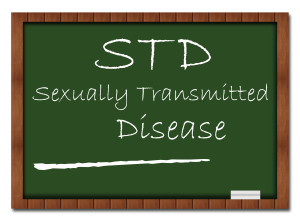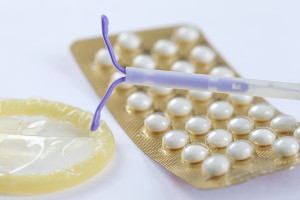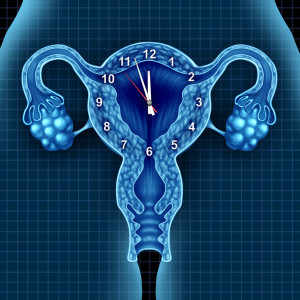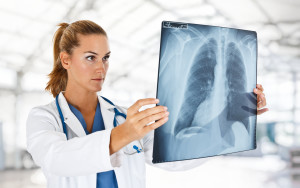 For many women, their periods are a routine certainty, the timing of which can be dependably calculated. For other women, their menstrual cycle may vary naturally. Abnormal delays, or entirely missed periods however, can be a cause of concern for women who are not trying to get pregnant. If your period is late, or has skipped entirely, and you are sexually active, you should consider the possibility that you may be pregnant; however there are several other factors that can cause a late or missed period that women should be aware of when considering possible reasons for the delay.
For many women, their periods are a routine certainty, the timing of which can be dependably calculated. For other women, their menstrual cycle may vary naturally. Abnormal delays, or entirely missed periods however, can be a cause of concern for women who are not trying to get pregnant. If your period is late, or has skipped entirely, and you are sexually active, you should consider the possibility that you may be pregnant; however there are several other factors that can cause a late or missed period that women should be aware of when considering possible reasons for the delay.
- Stress: Possibly one of the most significant factors that can impact various aspects of a woman’s normal body functioning is stress. When stress levels rise, a woman’s body can develop a condition called “hypothalamic amenorrhea.” The hypothalamus region of the brain regulates many of a woman’s hormones, however it is easily impacted by stress. If you are experiencing an extreme life event that has raised your stress levels, your hypothalamus may not properly regulate the hormones necessary for your menstrual cycle to occur as usual.
- Extreme Weight Loss: For women whose body mass indexes (BMI) drop rapidly below 18 or 19, they may begin to experience missed periods. Of greater concern, is the potential that such rapid weight loss is associated with anorexia or bulimia. A woman’s body will attempt to protect her from getting pregnant if her body is not healthy enough to support a fetus. When a woman’s BMI is extremely low, her body will prevent ovulation, resulting in low productions of estrogen, which halts the build-up of a woman’s uterine lining, and ultimately results in a missed period.
- Extreme Weight Gain: Similar to the menstrual impact of severe weight loss, women who experience a rapid increase in their weight can negatively impact their body’s ability to continue its normal menstrual cycle, and also may realize delayed or missed periods.
- Extreme Fitness Training: Women who are training for extreme, physically challenging events, such as running a marathon, or any other athletic competition that requires diligent hours of athletic training, may experience a skipped period. Extreme levels of fitness that put strain and stress on a woman’s body increase the likelihood that her body will halt her menstrual cycle due to her already taxed physical state.
- Issues with Your Birth Control Method: Women who take any form of oral, implantable, or injectable contraceptive should speak with their doctor to ensure they understand all of the risk factors and potential side effects of the medication. Some low-dose oral contraceptives can cause a lack of menses. Though not dangerous, it can be an unexpected and alarming side effect.
- Breast Feeding: Some women who have just given birth and are actively breastfeeding find that they do not return to a regular menstrual cycle until they have completed breast-feeding.
- Premature Menopause: In the United States, the average age of natural menopause is 51, however some women under 40 can experience what is known as premature ovarian failure, or premature menopause. For these women, their hormones are significantly imbalanced which can result in missed periods, among other physical side effects.
- Thyroid Irregularity: The thyroid gland regulates metabolism and assists in maintaining other normal body functions. Any type of thyroid imbalance may cause a woman’s period to be delayed or skipped entirely.
- Polycystic Ovary Symptom (PCOS): This condition results in a hormone imbalance that can halt ovulation, which can alter a woman’s normal level of estrogen, progesterone, and testosterone. Symptoms vary, with some women only experiencing menstrual irregularity, while others may miss their period entirely and repeatedly.
- Celiac Disease: This disease, which is characterized by an intolerance to gluten, if left untreated or undiagnosed, could add physical stress to a woman’s body and ultimately result in missed periods.
- Illegal Drug use: Aside from the highly addictive and dangerous nature of illegal drugs such as heroin, cocaine, LSD, mescaline, PCP, methamphetamine, and marijuana to name a few, use of these unnatural substances can also cause irregularities in a woman’s menstrual cycle.
If you feel that you are experiencing irregularities in your menstrual cycle that may be caused by any of the factors listed above, or if you think you may be pregnant, speak with your doctor so that he or she can help you understand the cause of your irregularity.
More
 Know the risks, signs, and symptoms of the most common STDs in women
Know the risks, signs, and symptoms of the most common STDs in women
Women who are sexually active, or who are thinking of becoming active, should know the risks involved, which includes the potential contraction of a sexually transmitted disease (STD). There are several STDs that sexually active women should know and understand before engaging in sexual behavior. The chart below outlines the most common STDs impacting women, how they can be contracted, their symptoms, and how they can be prevented.
STD: Human Papillomavirus (HPV)
Contraction: With more than 30 types of HPV, nearly every sexually active person will contract a form of HPV at some point in their lives. HPV can be contracted through vaginal, anal, or oral sex, and by skin-to-skin contact.
Signs & Symptoms:
- Most types of HPV have no symptoms, cause no harm, and your body will cure itself
- Other forms cause genital warts, while others infect the mouth and throat
- The worst strains can cause cancer of the mouth, throat, or cervix
Prevention: Two vaccines are available to protect against HPV, and one also protects against genital warts, vaginal cancer, and anal cancer. The CDC recommends young women ages 11 to 26 to get vaccinated for HPV.
STD: Chlamydia
Contraction: Chlamydia is the most common STD in the United States. It is spread by vaginal, anal, or oral sex.
Signs & Symptoms: Only 25 percent of women see symptoms, which can include:
- Odd discharge from your vagina
- Pain or burning during urination
Prevention: As with all STDs, practicing safe sex practices can help protect against contraction. Safe sex practices include:
- Abstinence
- Committing to one monogamous, long-term relationship with someone who has been tested for STDs
- Using latex condoms correctly and consistently
STD: Gonorrhea
Contraction: Gonorrhea is a bacterial STD, often contracted with Chlamydia during oral, vaginal, or anal sex.
Signs & Symptoms: Only 20 percent of women see symptoms, which can include:
- Odd discharge from your vagina
- Pain or burning during urination
Prevention: Follow the safe sex practices listed above and get tested right away in you develop genital warts.
STD: Syphilis
Contraction: Contracted through vaginal, anal, and oral sex. It is spread through direct contact of sores on a sexual partner, usually found on the genitals, anus, rectum, mouth and lips.
Signs & Symptoms: There are four stages to Syphilis, each with varying symptoms:
- Stage 1: Development of a sore that can look like a cut, an ingrown hair, or a bump
- Stage 2: Development of a rash on your body followed by sores in your mouth, vagina, or anus
- Stage 3: Symptoms usually disappear. This stage can last for years, or the rest of your life
- Stage 4: Affects 15 percent of those untreated and includes organ, nerve, and brain damage
Prevention:
- Follow safe sex guidelines
- Get tested regularly for STDs
- See your doctor if you develop any sores, blisters, bumps, or rashes
- Avoid sexual contact with anyone who has visible sores, discharge, blisters, or bumps in the genital area
STD: Herpes
Contraction: This easily contracted STD is spread by skin-to-skin contact with an infected sexual partner, including contact with the areas of the skin that a condom does not cover.
Signs & Symptoms:
- The primary symptom is painful blisters around the vagina or anus, or inside the vagina and anus, where they can be neither seen nor felt
- Both strains of herpes, HSV-1 and HSV-2 can cause genital herpes
- Other symptoms include flu-like symptoms, fever, and swollen glands
Prevention: Practice safe sex or absinence.
STD: Trichomoniasis
Contraction: This STD is caused by a tiny parasite, and infects more women than men. Trichomoniasis is contracted through vaginal contact.
Signs & Symptoms:
- 30 percent of those with the disease experience symptoms, which include itching, burning, or sore genitals
- Smelly, clear, white, yellowish or greenish discharge
Prevention:
- Practice safe sex practices
- Avoid sexual contact with anyone displaying the symptoms of Trichomoniasis
STD: HIV/AIDS
Contraction: HIV is the virus that causes AIDS. The virus is passed through fluids such as blood, semen, vaginal fluids, and breast milk. It can be transmitted by vaginal or anal intercourse or sharing a needle with someone who is infected.
Signs & Symptoms:
- Flu-like symptoms
- Muscle aches
- Fatigue
- Slight fever
- Weight loss
- Diarrhea
- Eventually, HIV will destroy the immune system, stopping the body’s ability to fight off infections
Prevention:
- Practice safe sex guidelines
- Use a condom correctly every time you have vaginal, oral, or anal sex
- Do not inject drugs, but if you do, only use sterile injection equipment and water, and never share your equipment with others
If you are experiencing anything out of the norm, don’t wait to get see your OB-GYN. He or she is familiar with STDs and can get you the help and treatment you need.
More
 One of the most frequently asked questions the doctors at Chouchani, Sayegh and Bagnarello receive from our pregnant patients is if they should or should not get an epidural. While many women are entering the delivery room demanding that they be given an epidural, other women are staunchly opposed to this form of pain management. Each expectant mother should have a thorough understanding of the pros, cons, and risks involved before she makes a determination as to whether or not she will accept an epidural during delivery.
One of the most frequently asked questions the doctors at Chouchani, Sayegh and Bagnarello receive from our pregnant patients is if they should or should not get an epidural. While many women are entering the delivery room demanding that they be given an epidural, other women are staunchly opposed to this form of pain management. Each expectant mother should have a thorough understanding of the pros, cons, and risks involved before she makes a determination as to whether or not she will accept an epidural during delivery.
The Procedure
To perform the epidural, an anesthesiologist will insert a needle between two spinal vertebrae in the lower back. A fine catheter is threaded through the needle, and then removed, so that a mixture of a local freezing agent and a pain medication can be administered into the injection site. As a result, the mother will experience numbness below the waist.
The Pros
Epidurals can provide effective pain relief in many cases, especially in the case of a long, or difficult labor. Additional pros of epidurals include:
- Mitigating exhaustion: When the pain of contractions keeps you awake, an epidural can ease the pain enough to allow for rest or even a nap.
- Calming anxiety and speeding labor: For women who are exceptionally nervous or anxious during birth, an epidural can ease pain, allowing a woman to become more calm and less tense, ultimately helping to speed delivery.
- Easier delivery for “sunny-side up” babies: If the cervix is fully dilated, but your baby is facing your belly button instead of your spine, an epidural can relax the muscles of your vagina and perineum, helping the baby to properly reposition for delivery.
- Controlling high blood pressure: For women who experience a spike in blood pressure during labor, an epidural can help lower blood pressure to safer levels.
- Enabling consciousness: For women in need of a non-emergency C-section, epidurals can allow you to remain awake through the final stages of birth.
The Cons
Undesired side effects of epidurals tend to increase with larger doses of medication, longer deliveries, or fetal distress. Cons of receiving an epidural may include:
- Partial relief: In approximately five to 10 percent of cases, an epidural only provides partial relief, which is improved when additional medication is administered, but only in 75 percent of cases.
- Less effective labor: Numbness may make it more difficult for you to push through contractions, which can prolong labor, resulting in the need for a forceps or vacuum delivery in approximately 38 percent of cases. In other instances, oxytocin is used to speed stalled delivery, a medication that poses its own risks. In other cases of stalled labor, Pitocin must be administered, increasing the chances of a C-section by two or three times for first time mothers.
- Perineal injury: Tears and other injuries are more common in women who use epidurals because of the increased need for a vacuum or forceps delivery.
- Respiratory complications: In some cases, the sensation of numbness extends too far up a woman’s body, which can make breathing and swallowing difficult.
- Difficulty urinating: Lower body numbness often requires the insertion of a catheter to empty your bladder.
- Limited mobility: Once an epidural is administered, you will be rendered mostly immobile, keeping you from walking the halls or moving around.
- Spinal headache: Approximately one percent of women who receive an epidural develop an often severe headache during or after labor, which may linger for days or even weeks in rare cases.
- Postpartum backache: An epidural can result in bruising at the injection site, or ligament strain from prolonged time spent in the labor position. Either of these complications can cause short or long-term postpartum backache. Long-term backaches are almost twice as likely to occur with an epidural than without.
- Dropping blood pressure: When an epidural causes too much of a drop in blood pressure, it can cause the baby’s heart to slow. Since a slowed heart rate could indicate a sign of stress in the baby, medications may be administered and if ineffective, a C-section may be necessary.
- Fever: Epidurals significantly increase the likelihood of developing a fever during labor. In case the fever signals infection, you and your baby may be unnecessarily treated with antibiotics. In some cases, your baby may be admitted to the neonatal intensive care unit (NICU) after delivery to rule out complications.
- Emotional detachment: With a loss of physical sensations, some mothers feel an emotional detachment from the labor process, which can also make it more difficult for nurses to assess the progress of the labor.
- Residual complications: In rare cases, further complications can include residual numbness, weakness caused by injury to nerves at the injection site, and most severely, brain damage or death.
- Undesired effects on the newborn: In some cases, epidural complications may cause side effects for the newborn including short-term neurobehavioral complications such as irritability, inconsolability, decreased ability for visual tracking, less efficient initial suckling behavior, and decreased responsiveness.
Of course deciding whether or not to get an epidural should be based on a conversation that you have with your doctor — on a case by case basis. Remember to talk to your doctor about your questions and concerns regarding the epidural procedure before your delivery, and be prepared to know the risks involved before you make your decision during labor.
More
 Why You May be Safer Giving Birth in a Hospital than at Home
Why You May be Safer Giving Birth in a Hospital than at Home
The birth of a child should be comfortable, and emotionally satisfying life experience. More importantly, however, it should be a safe experience for both mother and baby. While the number of planned home births is increasing, women considering delivering their babies in a non-hospital setting should be aware of the risk factors associated with home births before they make their delivery plans.
The reasons that women cite for wanting a home birth include:
- The perception that it will be more cost-effective
- A desire to receive minimal, or no medications during delivery
- Religious, philosophical, and cultural preferences
- A desire to have access to their own space, clothes, and bathroom
The most common reason that women give for wanting a home birth however, is a desire to feel the comfort and security of their own home where they are surrounded by family, friends, and health care providers of their choosing.
While the number of planned home births has risen, recent studies have shown that the lack of access to hospital critical care services may put the mother, though more likely the newborn, at a higher risk of complications and even death. New research indicates that the risk of a baby dying at birth, or shortly after, is nearly four times higher when delivered by a midwife in a home setting, compared to deliveries by a midwife in a hospital. Women experiencing their first delivery are at an even greater risk for infant mortality when delivering in a home setting.
If complications with the birth occur during the delivery, a home setting does not provide immediate access to critical care services. During a delivery, every second is crucial to obtaining a successful birth outcome. One of the most common complications with any delivery is stillbirth. When urgent conditions occur, babies are in need of critical care that cannot be issued in a home. If any type of emergency occurs during labor, a woman and her baby would need to be transferred to a hospital setting for emergency care. This delay of critical treatment may make the difference between the life and death of the infant, or its mother.
For women considering a home birth, know that additional risks exist in certain circumstances. Home births are strongly cautioned against for women who:
- Have diabetes, chronic hypertension, a seizure disorder or any chronic medical condition
- Have previously had a cesarean section
- Develop a pregnancy complication, such as preeclampsia, prior to labor
- Are pregnant with multiples, or whose baby does not settle into a position that allows for a headfirst delivery prior to labor
- Are less than 37 weeks or more than 41 weeks pregnant
If you have concerns about the comfort and security that you will feel delivering in a hospital setting, know that your birth will be made most comfortable when you choose an OBGYN who you know and trust. Have a discussion with your chosen OBGYN regarding your birth plan. He or she will work with you to make the birth of your baby as comfortable, and safe, as possible.
And if you are looking for a doctor who puts the health and care of moms and babies first, please call Chouchani, Sayegh and Bagnarello MD. We are currently accepting patients at all three of our locations in Western New York.
More
 Pills. Injectables. Implantables. Condoms. Diaphragms. Even the rhythm method. With so many contraceptive choices available to today, how can a woman know which choice is right for her and her body? What most women want to know when making this decision is what method do most health care professionals choose for themselves? The answer: An implantable device known as an IUD.
Pills. Injectables. Implantables. Condoms. Diaphragms. Even the rhythm method. With so many contraceptive choices available to today, how can a woman know which choice is right for her and her body? What most women want to know when making this decision is what method do most health care professionals choose for themselves? The answer: An implantable device known as an IUD.
A recent study published in the journal Contraception found that 40 percent of surveyed family planning providers between the ages of 25 and 44 who currently utilize protection use an intrauterine device, or IUD. In comparison, 16 percent reported using oral contraception, while only nine percent reported using condoms as their primary birth control method.
What is an IUD? An IUD is a small contraceptive device, often t-shaped, which is inserted into a woman’s uterus by her doctor. It is considered a long-acting, reversible contraceptive method. In addition to the study published by Contraception, IUDs have been endorsed by the American Academy of Pediatrics as an excellent method to prevent teenage pregnancy. What makes the IUD such a population choice among experts?
- It’s highly effective – Studies have shown the IUD to be 99 percent effective. Compare that to oral contraceptives that are only 91 percent effective, and condoms that are only 82 percent effective.
- Set it and forget it – Oral contraceptives require a woman to remember to take a specific pill at the same time every day. With life’s uncertainties, even the most disciplined woman can accidentally skip a dose. Once inserted, a woman does not need to do anything to maintain her IUD, and some can even be effective for as many as ten years.
- It’s reversible – Once an IUD is removed, a woman’s regular hormonal cycle will take over, and a woman can begin to attempt to conceive.
- There are options – There are multiple IUD products available for women to choose from. There are hormone-free options that can be effective for up to ten years, or versions that release low-doses of progesterone that can be safely used for five years, depending on a woman’s needs.
- It’s safe – Women considering IUDs are screened by their doctor to ensure that they are good candidates for the device, which decreases the risk of pelvic infections which have been associated with the devices in the past
With so many contraceptive options available to women, the IUD can be a convenient, safe, and effective solution for women of all ages and lifestyles. For more information on IUDs and options that may be available to you, speak to your doctor or make an appointment at WNY Ob-Gyn during your next visit.
More
 Understanding the signs of depression and anxiety
Understanding the signs of depression and anxiety
You’re having a bad day. Again. You’re feeling anxious and nervous, or even sad and hopeless. Everyone has moments of anxiety or sadness, but how do you know what your intermittent feelings of anxiousness or despondency are more than just a series of bad days? How do you know when you’re facing a more serious health issue and should seek treatment? Read on to learn more about anxiety and depression and their symptoms, and then take our brief questionnaire to determine if you should speak to a health care professional.
Mental illnesses such as anxiety and depression impact men and women differently, and for some women, only appear during pregnancy or the postpartum period. Two of the most common issues that women face are anxiety disorder and depressive disorder.
Anxiety Disorder
There are a variety of diagnosable anxiety disorders, including:
- Generalized anxiety disorder (GAD)
- Obsessive-compulsive disorder (OCD)
- Panic disorder
- Post-traumatic stress disorder (PTSD)
- Social phobia, or social anxiety disorder
It is believed that anxiety disorders can be caused by a variety of factors, including genetics, the environment, psychological factors, and development factors. Unlike the mild levels of nervousness that many people experience when faced with a finite stressful experience, anxiety disorders typically last at least 6 months, with symptoms escalating if untreated. Each anxiety disorder has different symptoms, but all are predicated upon an excessive, irrational fear and dread
Depressive Disorders
Depressive disorders are a more extreme, and interruptive form of the sadness that individuals can experience from time to time. When an individual suffers from depressive disorder, it can interfere with day-to-day functioning. Like anxiety disorder, depressive disorder comes in many forms that span the severity continuum including:<
- Minor depression
- Dysthymic disorder
- Major depressive disorder
- Psychotic depression
- Season affective disorder (SAD)
- Bipolar disorder
Scientists believe that depressive disorders are caused by genetic, biological, chemical, hormonal, environmental, psychological, and social factors. While signs and symptoms vary depending on the diagnosed condition, in general, symptoms of depressive disorder may include:
- Persistent sad, “empty” feelings
- Feelings of hopelessness and/or pessimism
- Feelings of guilt, worthlessness and/or helplessness
- Loss of interest in activities or hobbies
- Fatigue or decreased energy
- Difficulty concentrating
- Insomnia or excessive sleeping
- Overeating or appetite loss
- Suicidal ideation or attempted suicide
- Physical pain in the form of persistent aches or pains, headaches, cramps or digestive problems
If you feel that you are experiencing something more than occasional nervousness or despondency and that you may be suffering from anxiety or depressive disorder, complete the questionnaire below.
In the past month, have you (check all that apply):
Experienced repeated feelings of hopelessness or emptiness?
Experienced severe and unexplainable mood swings?
Felt like you are constantly worried about things you cannot control?
Worried about the amount of alcohol you consume on a daily or weekly basis?
Felt more than twice a week like you have little interest in activities, hobbies, work, friends or family?
Had difficulty sleeping more than twice per week?
Felt like you have no energy on most days?
Felt like you are worthless, a failure, or have let down your family, friends, or co-workers?
Had trouble concentrating or remembering details on a daily basis?
Felt like the world would be better off without you, or considered suicide?
If you checked 3 or more of the statements above, make an appointment to speak with your health care provider today. There are many available treatments for mental health disorders, and your physician can properly diagnose your condition and help you find a treatment plan that will work best for you.
Drs. Chouchani, Sayegh and Bagnarello are concerned for the overall health of our patients. We can recommend options and specialists to help you overcome anxiety and/or depression.
More
 How Much Time Do You Really Have to Get Pregnant?
How Much Time Do You Really Have to Get Pregnant?
When asked “where do you see yourself after you graduate college?” many young women confidently reply by reciting a heavily considered, regimented life plan:
“I’m going to land my dream job by 22, get engaged to the man of my dreams by 25, we’ll move in together at 26, we’ll get engaged by 27, and get married by 29. By 30 I’ll have become a senior executive in my company, and my husband and I will have three kids before I’m 35, a boy, and two girls, in that order.”
While it may sound like a quintessential and highly responsible plan, the reality is that life sometimes takes us by surprise, leaving us making modifications to our “final” plan along the way. For women whose unexpected life events result in a delay in childbearing, many report that they begin to feel the metaphorical ticking of their biological clock – an internal feeling of foreboding that they need to have a baby soon “before it’s too late.” What is this feeling that we associate with a ticking clock? At what age do women really begin to lose fertility, and what steps should women who want to have a baby take to ensure the highest likelihood for conception?
The term “biological clock” often refers to a woman’s increased maternal instincts as they age and worry that they will soon be too old to successfully naturally conceive. There is debate as to whether the ticking clock is a true physical and psychological response, or a socialized experience.
What is a known fact, however, is that as women age, their fertility levels decrease. In general, the best age for women to get pregnant and carry a healthy baby to term is between the ages of 20 and 35. Once women enter their 40s, as many as 40 percent of pregnancies end in miscarriage, and by the time they reach 45, only ten percent of women are able to conceive naturally. This statistic is a concern to many women today, as the number of older mothers is rising as women prioritize education and career before having children. In 1999, only 16 percent of new mothers were over age 35. By 2008, that number had increased to 23 percent.
Women who want to conceive may be able to look to their family history to determine the longevity of their fertility. If a woman’s mother or grandmother was able to conceive naturally into her late thirties and forties, she may be able to as well. Women should also avoid smoking, excess alcohol and recreational drug use, as all of these can negatively impact egg quality. Women who want to conceive should also maintain a healthy diet, and should lead an active lifestyle to ensure a healthy weight, to minimize the chances of miscarriage.
For women with questions or concerns regarding their fertility, their best bet, is to speak to their physician. Simple tests can determine a woman’s fertility, and a doctor can provide options for increasing the likelihood of conception as well as maintaining a healthy pregnancy. If you are looking for a top Ob-gyn practice in Western New York, please give Chouchani, Sayegh and Bagnarello MD a call today. We are accepting new patients.
More
 Lung Cancer is The Number One Cancer Killer of Women
Lung Cancer is The Number One Cancer Killer of Women
Every year, cancer claims the lives of over a quarter of a million women. Of all types of cancer, lung cancer is the number one killer of women, having surpassed breast cancer in 1987. Women of all ages should familiarize themselves with the causes and risk factors of lung cancer. With proper education, routine screenings, and a healthy lifestyle, women can reduce their risk of falling victim this deadly disease.
According to The American Lung Association, the rate of new lung cancer cases over the past 37 years has dropped 28 percent for men, but has risen 98 percent for women. Smoking contributes to 80 percent of lung cancer deaths in women. Cigarette smoke specifically causes the greatest lung cancer risk, and though the risk is not as high, pipe and cigar smoke exposure can also increase the risk of lung cancer. Women who smoke are 13 times more likely to develop lung cancer compared to women who have never smoked, with the risk of lung cancer increasing with every cigarette smoked over time.
There is a misconception that all lung-cancer cases are the result of smoking, but in reality one in five women diagnosed with lung cancer has never smoked. However, one of the greatest risk factors of lung cancer for non-smokers is exposure to second-hand smoke. Non-smokers have a 20-30 percent greater chance of developing lung cancer if they are exposed to secondhand smoke at home or work. Still, there are other non-tobacco related factors that can increase the risk of developing lung cancer.
Studies point to genetics, the presence of certain lung diseases such as chronic obstructive pulmonary disease (COPD), environmental factors such as air pollution, and exposure to hazardous materials such as radon, uranium, arsenic, nickel and chemicals like asbestos, as non-tobacco risk factors for developing lung cancer. Regardless of whether they smoke, women should know the signs of lung cancer and should make an appointment for a screening if they suspect their symptoms may be indicative of a serious condition. Lung cancer symptoms may include coughing, wheezing, shortness of breath, and bloody mucus.
The most important step that a woman can take to reduce her risk of lung cancer is to stop smoking. Once a woman has stopped smoking, her risk of developing lung cancer decreases annually as normal lung cells grow and replace damaged cells. Approximately 15 years after quitting, a woman’s risk of developing lung cancer will more closely mirror that of a life-long non-smoker. For those who are non-smokers, but are exposed to tobacco smoke from a family member or from a work environment, minimizing exposure to second hand smoke can help mitigate the risk of contracting the disease. If you think that your home or work environment may be exposing you to asbestos or radon gas, have your environment tested right away.
Living smoke-free, and maintaining a safe home and work environment free from hazardous materials, and knowing the signs and symptoms of the disease, are important steps to staying cancer-free. With proper preventive measures and early detection, women can reduce their risk of lung and other types of cancer.
At Western New York OBGYN we are committed to your health and well-being. If you are looking for a top OBGYN practice and live in the Buffalo area, give us a call, we are accepting new patients.
More
 Of all of life’s changes that impact a woman’s body, none may be as unpredictable as menopause. During both perimenopause, the time period shortly before menopause, and menopause, a woman’s estrogen levels fluctuate as her ovaries try to accommodate changing levels of hormone production. As a result, women may experience such uncomfortable symptoms as mood swings, depression, hot flashes, breast pain, and sleeplessness. If you are going through the phases of menopause, you don’t have to suffer. Follow these nine tips to help manage your symptoms and ease through the stages of life’s most unpredictable change.
Of all of life’s changes that impact a woman’s body, none may be as unpredictable as menopause. During both perimenopause, the time period shortly before menopause, and menopause, a woman’s estrogen levels fluctuate as her ovaries try to accommodate changing levels of hormone production. As a result, women may experience such uncomfortable symptoms as mood swings, depression, hot flashes, breast pain, and sleeplessness. If you are going through the phases of menopause, you don’t have to suffer. Follow these nine tips to help manage your symptoms and ease through the stages of life’s most unpredictable change.
- Exercise regularly. Exercising at least 20 minutes three times a week can help to ease hot flashes by lowering the amount of circulating follicle stimulating hormone (FSH) and luteinizing hormone (LH) in your body.
- Reclaim your balance with yoga. Many women report that one of the most frustrating side effects of menopause is an increased feeling of stress and agitation. Meditation and yoga are two calming practices that can help women to feel more relaxed and comfortable during menopause, improving their mood and positively affecting their endocrine system.
- Protect your body from bone loss. During menopause, women should increase the amount of both calcium and vitamin C in their diet to help limit bone loss, another commonly occurring side effect of changing levels of estrogen.
- Consider acupuncture. Acupuncture and acupressure have been known to limit hot flashes for many women and can be used effectively as a treatment for this uncomfortable symptom.
- Maintain a healthy level of cholesterol. For women who experience an increase in cholesterol levels during menopause, a transition to a low-fat and low calorie diet can help to keep their cholesterol at a healthy level. Menopausal women should especially eliminate foods from their diet that are high in animal fat.
- Get a good night’s sleep. Sleeplessness can be one of the most disruptive (and annoying) side effects of menopause. A natural way to improve your quality of sleep is to drink calming chamomile tea before bedtime, wind down by reading a book and limiting TV time, and set a sleep schedule and try to stick to it.
- Increase Vitamin D intake. Vitamin D offers several health benefits for women during menopause, including the promotion of healthy bone renewal, normal cell growth, and hormonal balance. A 15 – 20 minute walk in the sunshine can provide a woman with the necessary daily dose of Vitamin D to experience these benefits.
- Challenge your mind. Many women experience difficulty concentrating, or even memory loss, during menopause. Routinely participating in mind exercises, such as crossword or Sudoku puzzles, can help to challenge your mind and sharpen your memory.
- Avoid hot flash triggers. Some external factors may increase the likelihood of experiencing a hot flash. Women during menopause should wear light clothing, keep their bedroom cool at night, avoid eating spicy foods, drinking caffeine or alcohol, and smoking tobacco.
Menopause is a transformative stage in a woman’s life. The uncomfortable symptoms of menopause will not last forever. By leading a healthy lifestyle and making some simple lifestyle changes, women can ease through the transition of menopause with comfort and ease.
More

You’ve read the baby books, you’ve talked to your friends, and you’ve started picking out names. The only thing that you need to do now is to conceive. Preparing for pregnancy is an emotional, mental, and physical responsibility. Follow these 8 tips to best position your body to bring a healthy and happy baby into the world:
- Begin taking folic acid supplements. Taking 400 micrograms of folic acid a day for at least one month prior to conception and during your first trimester can decrease the chances of your baby being born with a neural-tube defect by 50 to 70 percent.
- Eliminate alcohol, tobacco, and drug use. Smoking and drug use can increase the risk of having a miscarriage, a premature birth, or a baby with low birth weight. Tobacco use can also affect your fertility, and may impact your ability to conceive. Read these tips to help quit smoking.
- Increase your consumption of healthy foods. Even before you conceive, make sure that your body has the nutrients needed for a healthy pregnancy. Increase your daily intake of fruits, vegetables, and whole grains, as well as foods that are high in calcium. Be sure to eat a variety of sources of protein, such as beans, nuts, poultry and meats. In addition to increasing your consumption of healthy foods, eliminate foods that may increase your risk of acquiring a food-borne illness. Reduce your intake of unpasteurized soft cheese, unpasteurized juices, cold deli meats, and raw and undercooked fish and poultry. These foods can have high rates of bacteria that can cause illness, and in the most serious cases lead to a miscarriage or stillbirth.
- Maintain a healthy weight. Women with a health body mass index (BMI) may be more readily able to conceive. A pregnant woman whose body weight is too high may experience delivery complications, while a woman whose weight is too low may give birth to an underweight infant.
- Begin, or stick to, an exercise routine. A healthy exercise program includes 30 minutes of moderate exercise at least three times per week. If you are not currently exercising on a regular basis, slowly increase the length and intensity of your workout routines. Once you become pregnant, continue your fitness routine, unless you experience complications or are advised to stop by your doctor. A consistent exercise routine can help you to maintain a healthy weight, improve your cardiovascular and pulmonary health, and can increase your flexibility, all of which will benefit you during your pregnancy.
- Reduce your caffeine intake. Women who are pregnant or are trying to conceive should not consume a large amount of caffeine. An overconsumption of caffeine has been linked to an increased risk of miscarriage.
- Be aware of your mental health. Women who suffer from depression are twice as likely to have problems with fertility. Women who are looking to get pregnant should obtain a mental health screening, especially if they have a family history of depression.
- Make an appointment with your OB-GYN. Last but certainly not least, you should make an appointment to see your doctor. He/she can assess your overall health and make sure everything is normal in order to give you and your baby the best start.
Preparing your body to carry a baby is an important aspect of pregnancy that should not be overlooked. A healthy body will be best able to carry a baby to full-term, enabling you to deliver a healthy baby without complications. Chouchani, Sayegh and Bagnarello MD is accepting new patients. Give us a call today.
More
 For many women, their periods are a routine certainty, the timing of which can be dependably calculated. For other women, their menstrual cycle may vary naturally. Abnormal delays, or entirely missed periods however, can be a cause of concern for women who are not trying to get pregnant. If your period is late, or has skipped entirely, and you are sexually active, you should consider the possibility that you may be pregnant; however there are several other factors that can cause a late or missed period that women should be aware of when considering possible reasons for the delay.
For many women, their periods are a routine certainty, the timing of which can be dependably calculated. For other women, their menstrual cycle may vary naturally. Abnormal delays, or entirely missed periods however, can be a cause of concern for women who are not trying to get pregnant. If your period is late, or has skipped entirely, and you are sexually active, you should consider the possibility that you may be pregnant; however there are several other factors that can cause a late or missed period that women should be aware of when considering possible reasons for the delay.








